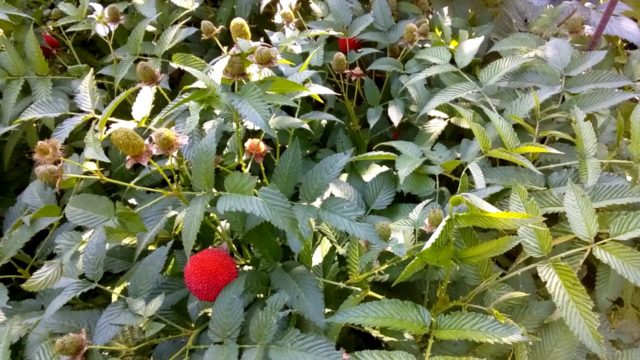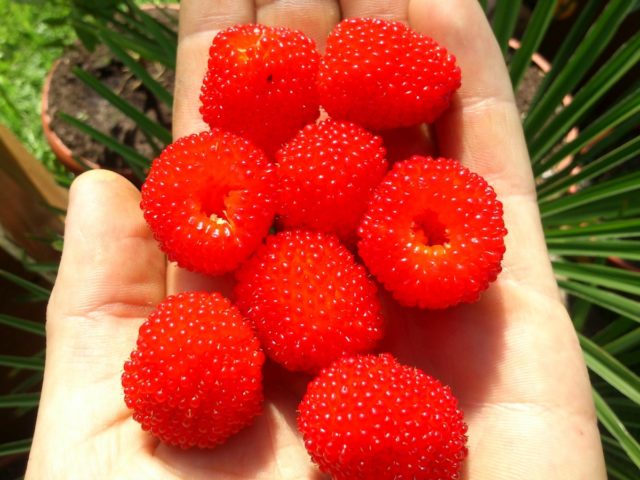Content
Norwegian raspberry is one of the trade names for a crop that has been obtained in Norway through years of selection of the best seedlings. According to the creators, the harsh climate of this country contributed to the development of a frost-resistant variety of culture that can fully grow and bear fruit in adverse conditions. The description and reviews about Norwegian raspberries are very contradictory, so it is worth figuring out what kind of plant it is, what are its advantages and disadvantages.
Description of Norwegian Raspberry
Norwegian raspberry is a half-shrub 1 m high. Its rhizome is creeping, which quickly grows and captures new territories.
The shoots of the semi-shrub are erect, lignified only at the base, and the upper part is covered with green bark throughout the season. The foliage of the Norwegian raspberry is feathery, oval-lanceolate, reaching a length of 3-8 cm, with characteristic denticles along the edge of the leaf plate. All shoots are densely covered with needles.
The flowers of the Norwegian raspberry are white, consist of 5 petals and reach a diameter of 4 cm. They are bisexual and can be single or collected in small inflorescences. Flowers are located at the tops of the shoots. The flowering period for Norwegian raspberries begins in the second decade of June and lasts until the onset of frost. Therefore, the plant can contain berries and flowers at the same time.
The fruits of this variety of culture are large in size - from 3 to 5 cm, with a pleasant seductive shine. The coral red berries are circular or elliptical and can be easily removed from the shoots. Their taste is sweet and sour with an unobtrusive aroma. The sweetness of the fruits is achieved only when they are fully ripe, therefore it is not recommended to harvest at the stage of slight redness. Saplings begin to bear fruit at the age of 3-4 years.
Pros and cons of Norwegian raspberries
Before planting Norwegian raspberries on your site, you should study its advantages and disadvantages.
Main pluses:
- high commercial qualities;
- resistant immunity to diseases and pests;
- abundant and prolonged fruiting, subject to the rules of agricultural technology;
- unusual refreshing taste.
In addition to obvious advantages, this type of culture also has certain disadvantages. This explains its low popularity among gardeners.
Cons of Norwegian Raspberries:
- an abundance of thorns, which makes it difficult to harvest;
- fruiting in the 3-4th year;
- increased demand for care;
- bushes grow strongly, so planting must be limited.
Planting and caring for Norwegian raspberries
Norwegian raspberries need increased attention from a gardener, and you should immediately assess your strengths realistically. With insufficient care and nutrition, fruiting is scarce and short-lived.Therefore, it is worthwhile to study in advance all the subtleties of planting and the secrets of further care, so that the experience of growing this type of culture does not become sad.
The photo shows a Norwegian raspberry, which is in the fruiting stage. Such a crop can be obtained no earlier than the plant reaches the age of 3 years.
Selection and preparation of the landing site
This type of culture prefers to grow in sunny, open areas. When the seedlings are placed in partial shade, the shoots are stretched out, and the number of flowers is significantly reduced.
Planting of Norwegian raspberries is carried out in the spring. To do this, you must first prepare the site by digging it onto the bayonet of a shovel with careful removal of weeds. The plant grows well on light nutritious soils, but can also grow on loams and black soil. In this case, the acidity level should be within 5.7-6.5 pH.
At the beginning of spring, it is necessary to prepare planting pits measuring 40:30:30 cm. It is recommended to place seedlings at a distance of 80-90 cm in a row, and the row spacing should be at least 1.5 m.For the full growth and development of Norwegian raspberries at the initial stage, it is necessary fill the landing grooves with the nutrient mixture.
To prepare it, you will need to mix the following components:
- 2 parts of the top nutrient layer of the earth;
- 1 part of humus;
- 40 g of potassium sulfide;
- 25 g superphosphate;
- 1 part peat.
The preparation of the site for planting Norwegian raspberries must be carried out in advance: 10-14 days, which will allow the soil to settle during this period.
Planting rules for Norwegian raspberries
Norwegian raspberries have the ability to grow quickly and will fill all neighboring areas in a few years. Therefore, before planting around the planting pit, you need to dig in slate or plastic, which will not allow the plant to spread uncontrollably.
Procedure for landing.
- Spread out the root shoots of the seedling, remove damaged areas to healthy tissue.
- Place the plant in the center of the planting hole.
- Sprinkle it without deepening the root collar.
- Compact the soil with your hands at the base.
- Water abundantly at the rate of 5 liters per plant.
The next day, loosen the soil at the base of the seedling and lay the peat mulch in a layer of 3-5 cm.
Watering and feeding
For 2 weeks after planting, it is necessary to constantly monitor the soil moisture so that the roots do not dry out. Watering during this period is recommended 2 times a week, pouring 5 liters of water under each plant. After the seedlings get stronger and grow, watering should be carried out as needed once a week.
In the first year, fertilization is not worth it if the nutrient mixture was introduced during planting. Next spring, the first feeding should be carried out during the active growing season with nitrogen fertilizers and during flowering with potash fertilizers.
Pruning
There is no acute need for pruning Norwegian raspberries, since with the arrival of frost, the aerial part of the plant completely dies off. It is enough to carry out a sanitary cleaning of the bushes during the season, removing broken, damaged and weakened shoots.
Preparing for winter
The Norwegian raspberry is a frost-hardy crop, but in a snowless winter, its surface roots can freeze out. Therefore, in the fall, after the upper part of the plant dies off, cover the soil with a layer of peat or humus 10 cm thick.
In the northern regions with a particularly harsh climate, it is recommended to spread agrofibre on the site with Norwegian raspberries.
Harvesting
The fruiting period for this crop variety begins in late June - early July. It is recommended to pick berries as soon as they are fully ripe. The readiness of the fruit can be judged by how easily they are separated from the receptacle.
Reproduction
Norwegian raspberries reproduce by strictly dividing the bush.When sowing seeds, the obtained seedlings do not retain their species properties.
It is recommended to separate the segments of the plant in the spring, when new mature shoots appear. In autumn, it is impractical to do this, since during this period the growth processes slow down.
Diseases and pests
Norwegian raspberries are highly resistant to pests and fungi. But if the rules of agricultural technology are not followed, the immunity of seedlings decreases. Also, high humidity and thickening of the plantings can become a provoking factor of defeat.
Possible problems:
- Powdery mildew... For treatment, treatment with "Topaz", "Skor", and copper sulfate is used.
- Chlorosis... For elimination, it is recommended to use iron chelate.
- Root cancer, yellow mosaic... These viral diseases cannot be treated, the affected seedlings are uprooted and burned.
- Weevil, raspberry beetle... It is recommended to use "Karbofos" for pest control.
Conclusion
Descriptions and reviews of Norwegian raspberries are very diverse. Some gardeners argue about the benefits of this type of culture, others share sad experiences. Lack of truthful information leads to the fact that this plant has not gained wide popularity in Russia. But if you follow the recommendations for growing a crop, you can achieve the desired result and then a generous harvest of unusual berries will be a reward for your efforts.











